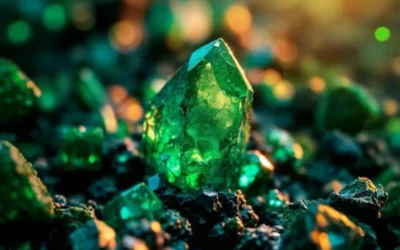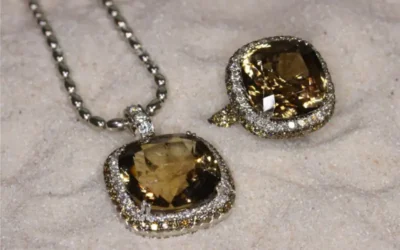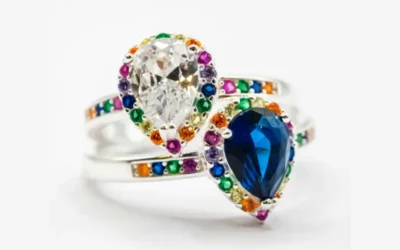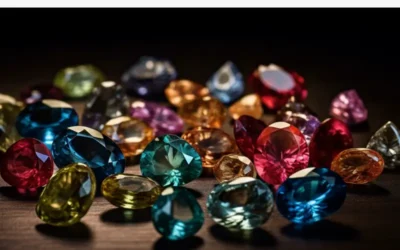The Rainbow Revolution: Why Colored Lab-Grown Diamonds Are Redefining Luxury
For centuries, the allure of colored diamonds was reserved for fairy tales, royalty, and the ultra-wealthy. Vivid blues, passionate pinks, and sunshine yellows seemed like distant dreams, locked away behind price tags reaching millions.But a seismic shift is reshaping the diamond world.
Colored lab-grown diamonds, born from cutting-edge science and ethical commitment, are shattering those old barriers, bringing the extraordinary beauty of nature’s rarest hues within reach. Imagine owning a diamond once considered a museum piece – now, it’s not just possible; it’s a conscious, stunning choice.
The global market for these vibrant creations is projected to surge past $XX billion by 2031 (QYResearch), driven by a generation demanding sustainability without compromise. This isn’t just an alternative; it’s a revolution merging innovation, ethics, and breathtaking artistry, making rare beauty truly accessible. Let’s dive into the radiant world beyond the traditional clear stone.
The Science Behind the Sparkle: Crafting Nature’s Palette in the Lab
 How does a diamond get its dazzling color? Understanding the magic – both natural and human-made – deepens the appreciation.
How does a diamond get its dazzling color? Understanding the magic – both natural and human-made – deepens the appreciation.
In nature, colored diamonds are happy accidents, forged under extreme pressure and heat deep within the Earth over billions of years. Trace elements sneak into the diamond’s pure carbon structure: Nitrogen atoms create warm yellow and orange hues. Boron is the secret behind mesmerizing blue diamonds. Natural green diamonds result from exposure to radioactive elements near the Earth’s surface, altering their crystal lattice. The coveted pink and red diamonds? These are often formed by intense “plastic deformation” during their journey upwards, twisting the crystal structure to bend light into those romantic shades. These conditions are incredibly rare and unpredictable.
Lab-grown diamond technology, however, masters this color chemistry with remarkable precision. Scientists don’t just mimic nature; they refine it. Using two primary methods, they create stunning colored diamonds:
-
HPHT (High-Pressure High Temperature): This process replicates the Earth’s natural diamond-forming conditions. A tiny diamond seed is placed in a press with pure carbon and a metal catalyst. Subjected to immense pressure (over 1.5 million pounds per square inch) and temperatures exceeding 2,700°F, the carbon melts and crystallizes around the seed. HPHT excels at producing vibrant yellow and blue diamonds, thanks to controlled nitrogen or boron introduction. It’s generally a faster growth process.
-
CVD (Chemical Vapor Deposition): Think of this as diamond “printing.” A diamond seed is placed in a vacuum chamber filled with carbon-rich gas (like methane) and hydrogen. Microwaves or other energy sources break down the gas molecules, releasing carbon atoms that rain down and layer onto the seed, building the diamond atom by atom. CVD offers unparalleled control, making it ideal for producing stunning pinks, reds, and incredibly pure Type IIa colorless diamonds (representing the top 2% in quality). It allows for finer manipulation of the diamond’s structure to achieve specific, rare colors.
A key advantage of lab creation? Unmatched Color Purity. Natural diamonds often contain impurities that cause unwanted brown or gray undertones. Labs can meticulously control the growth environment, minimizing these impurities and yielding colors that are often more saturated, vibrant, and consistent than their natural counterparts. This scientific artistry unlocks nature’s most coveted palette predictably and beautifully.
A Kaleidoscope of Choice: Exploring the Spectrum of Lab-Grown Color
Gone are the days of limited options. The world of colored lab-grown diamonds offers a breathtaking spectrum, each hue with its own story, cause, and unique charm. Let’s explore the most sought-after fancy colors:
-
 Vivid Yellow: The most accessible and popular fancy color, yellow lab diamonds get their sunny disposition from controlled nitrogen impurities during growth. They offer incredible warmth and brilliance, often at 20-30% lower prices than comparable natural yellow diamonds. This affordability makes them perfect for bold statement rings, dazzling tennis bracelets, or adding a pop of sunshine to any ensemble. They radiate joy and confidence.
Vivid Yellow: The most accessible and popular fancy color, yellow lab diamonds get their sunny disposition from controlled nitrogen impurities during growth. They offer incredible warmth and brilliance, often at 20-30% lower prices than comparable natural yellow diamonds. This affordability makes them perfect for bold statement rings, dazzling tennis bracelets, or adding a pop of sunshine to any ensemble. They radiate joy and confidence. -
Electric Blue: Perhaps the epitome of cool sophistication, blue lab diamonds owe their mesmerizing hue to the precise introduction of boron atoms. Naturally occurring blue diamonds are among the rarest and most expensive on Earth. Lab technology democratizes this exclusivity, making the deep, oceanic blues and vibrant teals accessible. They are a stunning choice for engagement ring center stones, offering a unique and modern twist on tradition, symbolizing depth, loyalty, and calm strength.
-
Blush Pink: Synonymous with romance and femininity, pink lab diamonds are highly coveted. Their delicate color typically arises from carefully engineered lattice deformation within the crystal structure during CVD growth. Achieving consistent, desirable pink shades is a specialty of the CVD process. Their soft, ethereal glow makes them ideal for halo settings (where smaller diamonds surround the center stone), accent stones in intricate designs, or elegant solitaire pendants. Pink diamonds whisper elegance and timeless charm.
-
Forest Green: Representing nature, renewal, and prosperity, green lab diamonds are created through controlled exposure to radiation, replicating the natural process that gives them their unique hue. Lab-grown greens offer remarkable clarity and depth of color. They are a powerful symbol of sustainability, perfectly aligning with the eco-conscious values of lab-grown diamond buyers. Their earthy elegance shines in nature-inspired designs, vintage-style pieces, or as striking center stones for those who dare to be different.
-
Rich Red: The holy grail of colored diamonds. Natural reds are vanishingly rare. Lab technology now makes achieving this passionate, fiery hue possible through the creation of specific, rare structural defects. Red lab diamonds are true collector’s items, radiating intensity, power, and unparalleled luxury. They command attention and are destined for extraordinary heirloom pieces and bespoke jewelry designs for those seeking the ultimate statement of uniqueness.
This vibrant spectrum empowers you to choose a color that resonates deeply with your personality, style, and values. The possibilities for self-expression are limitless.
Why Choose Colored Lab Diamonds? The Unbeatable Triple Advantage
Choosing a colored lab-grown diamond isn’t just about aesthetics; it’s a decision grounded in powerful benefits that resonate deeply with modern values:
-
Ethical & Environmental Leadership: This is perhaps the most compelling driver. Colored lab-grown diamonds offer a clear conscience. Their creation involves zero mining, eliminating the devastating habitat destruction, soil erosion, and water pollution often associated with traditional diamond extraction. Forget the “earth’s scars” – labs create beauty above ground. Leading producers like Diamond Foundry utilize renewable energy sources (including solar power), drastically reducing the carbon footprint compared to mined diamonds. Furthermore, they provide a 100% conflict-free guarantee. You can wear your stunning jewel knowing it bypasses any association with “blood diamonds” or human rights abuses linked to some mining regions. Your luxury is truly guilt-free.
-
Exceptional Value & Accessibility: Lab-grown technology fundamentally changes the economics of rare colors. Colored lab diamonds typically cost 30-50% less than their natural counterparts of identical quality, color, and size. Consider this: a stunning 1-carat vivid blue natural diamond might easily command $200,000 or more. A visually identical blue lab diamond could be a fraction of that price, perhaps around $5,000-$15,000 depending on specifics. This dramatic price difference creates the “same price = 2x carat size” effect. Your budget can stretch significantly further, allowing you to choose a larger, more impactful colored stone or allocate savings towards a bespoke setting design. You get extraordinary beauty without the extraordinary price tag.
-
Unparalleled Creative Freedom: For designers and wearers alike, colored lab diamonds unlock a world of creative possibilities unconstrained by natural rarity. Jewelers can experiment with custom cuts – intricate rose cuts, dramatic kites, modern hexagons, or fantasy shapes – that maximize the play of light and unique character of each colored stone, without the fear of excessive waste from rare natural rough. For consumers, this means access to truly one-of-a-kind designs. Perhaps the most significant advantage? Perfectly matched suites. Creating flawless pairs of identically colored and sized diamonds for earrings, or a perfectly graded sequence for a tennis bracelet or necklace, is incredibly difficult and prohibitively expensive with natural colored diamonds. Labs can produce these matched sets with relative ease, making coordinated colored diamond jewelry a practical and breathtaking reality. Your vision isn’t limited by what nature happened to produce.
The Market Shift: Colored Lab Diamonds Go Mainstream
The rise of colored lab-grown diamonds isn’t a niche trend; it’s a fundamental market evolution backed by data and cultural change. Industry analysts project a robust Compound Annual Growth Rate (CAGR) of 13.92% for the lab-grown diamond market between 2025 and 2035, with the Asia-Pacific region leading the charge as the fastest-growing market. Several powerful forces fuel this boom:
-
Celebrity Endorsement & Influence: High-profile figures embracing lab-grown diamonds lend significant credibility and desirability. Emma Watson, a vocal advocate for sustainable fashion, has been spotted wearing pieces featuring lab diamonds. Meghan Markle’s choices also influence consumer perception. When celebrities choose lab-grown, particularly colored stones, it signals that this is a legitimate and stylish form of luxury.
-
Major Brand Pivots: Established jewelry giants are taking notice and adapting. Pandora, the world’s largest jewelry brand, made headlines by completely ditching mined diamonds in favor of exclusively using lab-grown stones across all its collections. Even traditional mining powerhouse De Beers launched its lab-grown brand, Lightbox (though initially focused on fashion jewelry, it represents a significant industry acknowledgment). These moves validate the market and bring lab-grown options to vast consumer bases.
-
The Cultural Imperative: Sustainability is no longer a bonus; it’s a demand, especially from millennials and Gen Z, who are becoming the dominant luxury spenders. Studies consistently show that over 74% of millennials prioritize sustainability in their luxury purchases. The success of brands like MONOLOGUE (known for recycled gold and conscious designs) underscores this shift. Colored lab-grown diamonds, embodying both sustainability and unique self-expression, perfectly align with these values. Consumers aren’t just buying a diamond; they’re aligning their purchase with their ethical worldview and desire for individuality.
This convergence of data, influential adoption, and deep cultural values ensures that colored lab diamonds are not a passing fad, but a defining feature of the future jewelry landscape.
Addressing Common Questions & Concerns
With any innovation comes questions. Let’s tackle the most common concerns about colored lab-grown diamonds head-on:
-
 “Are They Real Diamonds?” Absolutely, Undeniably. This is the most fundamental question. Colored lab-grown diamonds possess identical physical, chemical, and optical properties to diamonds formed deep within the Earth. They are crystalline carbon structured in the same cubic lattice. The U.S. Federal Trade Commission (FTC) explicitly defines a diamond as “a mineral consisting essentially of pure carbon crystallized in the isometric system,” without specifying origin. Reputable labs like the International Gemological Institute (IGI) and the Gemological Institute of America (GIA) provide certification for lab-grown diamonds, verifying their authenticity and grading their quality (Cut, Color, Clarity, Carat). While GIA reports historically used different terminology for lab-grown, they now clearly identify them as laboratory-grown diamonds. IGI reports are often praised for their detailed specificity regarding color origin and treatment.
“Are They Real Diamonds?” Absolutely, Undeniably. This is the most fundamental question. Colored lab-grown diamonds possess identical physical, chemical, and optical properties to diamonds formed deep within the Earth. They are crystalline carbon structured in the same cubic lattice. The U.S. Federal Trade Commission (FTC) explicitly defines a diamond as “a mineral consisting essentially of pure carbon crystallized in the isometric system,” without specifying origin. Reputable labs like the International Gemological Institute (IGI) and the Gemological Institute of America (GIA) provide certification for lab-grown diamonds, verifying their authenticity and grading their quality (Cut, Color, Clarity, Carat). While GIA reports historically used different terminology for lab-grown, they now clearly identify them as laboratory-grown diamonds. IGI reports are often praised for their detailed specificity regarding color origin and treatment. -
“What About Resale Value?” Framing the Investment Correctly. It’s true that currently, colored lab-grown diamonds typically have lower resale value compared to natural colored diamonds. However, this perspective needs context:
-
Natural diamonds also depreciate: The notion that natural diamonds are great financial investments is largely a myth. Most natural diamonds lose significant value (often 50% or more) the moment they leave the jewelry store. Their value primarily lies in sentiment and aesthetics, not as a liquid asset.
-
Value Proposition Reframed: The value of a colored lab diamond should be viewed through a different lens: Exceptional upfront value (getting a larger, more vibrant stone for your budget), investment in design and craftsmanship (supporting bespoke jewelry creation), and investment in ethics and sustainability (values that hold increasing importance). They are purchases for personal joy and alignment with principles, not speculative commodities.
-
-
“Lacking the Emotional Connection of Natural Stones?” Meaning is Made, Not Mined. The emotional resonance of a diamond comes from the story you attach to it. Is it the symbol of your commitment in an engagement ring? A celebration of a milestone? A piece of art you cherish? The origin story – whether forged over millennia underground or crafted with human ingenuity in weeks – becomes part of your unique narrative. A diamond’s true meaning is imbued by the wearer and the occasion it represents. “A diamond’s magic comes from the love it symbolizes and the hand it adorns, not the depth from which it was pulled.” Focusing on the beauty, the ethical choice, and the personal significance creates a powerful and authentic emotional connection.
Your Smart Buyer’s Guide to Colored Lab Diamonds
Ready to explore the world of colored lab diamonds? Empower yourself with this essential checklist for a confident and satisfying purchase:
-
Prioritize Independent Certification: Never skip this step. Insist on a grading report from a reputable laboratory like IGI or GIA specifically for the diamond you are considering. This report is your guarantee of authenticity and provides an objective assessment of the 4Cs (Cut, Color, Clarity, Carat weight). Crucially, for colored lab diamonds, the report should explicitly state “Laboratory-Grown” and detail the color grade (e.g., “Fancy Vivid Yellow”). IGI reports are often particularly detailed for lab-grown color. Avoid sellers who cannot or will not provide this documentation.
-
Choose Transparent and Reputable Retailers: Seek out established jewelers known for their expertise and ethical sourcing. Look for brands that openly share information about their diamond origins and growth processes. Brands partnering with leading producers like GLARINS (known for sustainable practices) or specialists like JOY COLORi (focused on fancy color) or Kira Diam often have strong reputations. Read reviews and ask questions about their sourcing and warranties.
-
See the Color in Context (Virtually or In-Person): Color perception is highly sensitive to lighting. A diamond can look significantly different under fluorescent store lights, natural daylight, or candlelight. Always request high-quality videos of the exact stone you’re interested in, showing it rotating under multiple light sources. If possible, view the diamond in person. Pay close attention to the saturation and tone – does the color look vibrant and appealing to your eye? Don’t rely solely on a certificate’s color grade description.
-
Embrace Customization for Maximum Impact: One of the greatest joys of colored lab diamonds is the freedom to create something unique. Work with a skilled jeweler to design a setting that truly enhances your chosen stone’s color. Consider how metal choice interacts with the diamond: Rose gold can intensify the warmth of yellows and pinks, while white gold or platinum might make blues and greens pop. Think about side stones, halos (using white or contrasting colored diamonds), and overall style to create a cohesive and breathtaking piece. Your colored diamond deserves a setting worthy of its uniqueness.
Beyond Adornment: The Future Shines Bright
The potential of colored lab-grown diamonds extends far beyond stunning jewelry. Their unique properties are unlocking groundbreaking applications:
-
 Industrial & Technological Powerhouses: Certain colored diamonds, particularly blue diamonds (due to boron acting as a semiconductor) and potentially red diamonds (with specific defects), are being intensely researched for next-generation electronics, high-power lasers, radiation detection, and even cutting-edge quantum computing applications. Their exceptional hardness, thermal conductivity, and optical properties make them invaluable in high-tech fields.
Industrial & Technological Powerhouses: Certain colored diamonds, particularly blue diamonds (due to boron acting as a semiconductor) and potentially red diamonds (with specific defects), are being intensely researched for next-generation electronics, high-power lasers, radiation detection, and even cutting-edge quantum computing applications. Their exceptional hardness, thermal conductivity, and optical properties make them invaluable in high-tech fields. -
The Cultural Tipping Point: As Generation Z matures and becomes the dominant luxury consumer force, their deeply ingrained values around sustainability, transparency, and individuality will become non-negotiable. Colored lab-grown diamonds, perfectly embodying these principles while offering unique beauty, are poised to become the standard, not the alternative. Ethical sourcing will be the baseline expectation.
-
Innovation Horizon: The science of diamond growth is constantly advancing. What once seemed impossible is now reality. Keep an eye on emerging possibilities: Can specific irradiation techniques unlock consistent ultra-rare violet hues? Will novel doping methods create entirely new colors? Could processes related to nuclear technology yield even more intense reds? The future palette of lab-grown diamonds promises to be even more extraordinary.
Conclusion: Color is the New Signature of Style
The era of the diamond is evolving, brilliantly and boldly. Colored lab-grown diamonds are not merely substitutes for traditional stones; they represent a profound upgrade for the conscious, style-savvy individual. They offer beauty without ethical compromise, rarity without exorbitant cost, and self-expression without limits. They are diamonds forged with human ingenuity and care for our planet, carrying all the fire, brilliance, and enduring symbolism of their natural counterparts – plus a powerful story of progress.
These vibrant stones allow you to defy convention and declare your unique taste. Whether you’re drawn to the sunny optimism of yellow, the tranquil depth of blue, the romantic blush of pink, the grounding energy of green, or the fiery passion of red, there’s a colored lab diamond waiting to become your signature piece. It’s a choice that sparkles with intelligence, responsibility, and undeniable allure.
Ready to embrace the rainbow revolution? Discover the breathtaking spectrum of colored lab diamonds and begin designing the unique masterpiece that tells your story – where ethics and extraordinary beauty truly shine together. What color will you choose?






